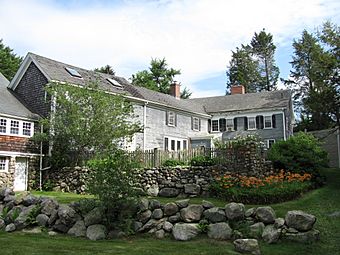Hoar Tavern facts for kids
Quick facts for kids |
|
|
Hoar Tavern
|
|

North view of the Hoar Homestead
|
|
| Location | Lincoln, Massachusetts |
|---|---|
| Area | 2 acres (0.81 ha) |
| Built | 1680 |
| NRHP reference No. | 73000301 |
| Added to NRHP | July 23, 1973 |
The Hoar Tavern, also known as the Hoar Homestead, is a very old house and former tavern in Lincoln, Massachusetts. It was built around 1680, making it one of the oldest buildings in the area. For almost 200 years, it was home to the Hoar family, who were important people in Massachusetts law and government. This historic building was added to the National Register of Historic Places in 1973.
Contents
Exploring Hoar Tavern: A Historic Building
The Hoar Tavern is located in eastern Lincoln, near Massachusetts Route 2. The property is about 2 acres (0.81 ha) in size. It includes the main house, which used to be the tavern, and an old barn. Today, the house and barn are connected by an addition.
What Does the Tavern Look Like?
The tavern is a two-and-a-half-story building made of wood. It faces south towards Route 2, which was once an old road called the Cambridge Turnpike. The front of the house has five sections with windows and a door in the middle. It has a large chimney in the center and is covered with wooden siding called clapboards.
Inside, you can see beautiful wood panels from the 1700s. The building also shows signs of its very early construction style, known as "First Period" architecture. The barn is also very old and has thick wooden beams, some as wide as 18 inches (46 cm).
The Hoar Family: Owners of the Homestead
The Hoar family lived in this house for many years. Daniel Hoar likely built the house in the 1680s. At that time, this area was part of Concord.
Hoar Family and the American Revolution
Daniel's son, John, and grandson, Samuel, were active in local town matters. They both fought in the Battles of Lexington and Concord. These battles marked the beginning of the American Revolutionary War.
Important Hoar Family Members
Samuel's son, also named Samuel, became a leading lawyer in Massachusetts. His sons, Ebenezer Rockwood Hoar and George Frisbie Hoar, became very important in state and national politics. The Hoar family ran the property as a tavern for over a century. They sold the property in 1869.



